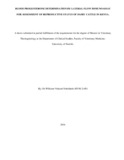| dc.description.abstract | The livestock sector in Kenya contributes about 10% of the Gross Domestic Product (GDP) with
the dairy subsector accounting for 4%. Eighty percent of this contribution is from small scale dairy
farmers currently challenged by low reproductive efficiency caused by poor estrus detection,
delayed determination of unsuccessful artificial insemination (AI) and sub-optimal calving to
conception interval. Blood levels of progesterone (P4) are a valid indicator of the reproductive
status of an animal. The current study sought to document P4 levels that could be used to
determine the estrous phase of the cows to enable prompt remedial action where it was
unsuccessful to optimize reproductive efficiency.
The P4 levels were determined using the lateral flow immuno assay (LFIA) and also the
knowledge, attitude and practices of various stakeholders in the dairy industry on the use of P4 as a
reproductive management tool was evaluated.
Blood was collected from 46 animals to establish the P4 profiles at the various stages of the
reproductive cycle using enzyme linked immunosorbent assay (ELISA). Subsequently, P4 levels
analyzed by LFIA and ELISA in blood from 100 dairy cattle were compared for the degree of
agreement. Questionnaires were administered to various stakeholders in the dairy industry to
determine their knowledge, attitude and practices on use of P4 as a reproductive management tool.
Animal Health Practitioners (n=127) and dairy farmers (n=25) were interviewed in the present
study. There was limited knowledge amongst dairy cattle industry stakeholders on the LFIA P4 kit
and lack of its use in reproductive management of dairy cattle.
The P4 profiles of dairy cattle ranged from 0.2-10ng/ml. Pre-pubertal animals and those in the
follicular phase of the cycle had P4 levels of 0.2 to 2.8ng/ml. Non-pregnant luteal phase and
pregnant animals had higher (p<0.05) P4 levels ranging between 4 to 10ng/ml. LFIA P4 scores
ranged from 1 to 2 for pre-pubertal and follicular phase animals. The scores were higher (p<0.05)
ranging from 2.5 to 3 for non-pregnant luteal phase and pregnant animals. The semi-quantitative
P4 levels as determined by the LFIA were highly correlated (r 0.95; kappa=0.93) with the
quantitative ELISA P4 levels of 0-4 ng/ml and 4-10 ng/ml, respectively for low and high P4
concentrations. The breed, body condition and weight did not influence the concentration of P4
levels. Progesterone levels as determined by ELISA were higher (p<0.05) for pregnant than nonpregnant
luteal phase animals.
Forty two percent of Animal Health Practitioners (AHP) and none of dairy farmers were aware of
P4 kits for heat detection whereas 46% of AHP and 4% of dairy farmers were aware of P4 kits for
pregnancy diagnosis. Overall, a larger proportion of both the dairy farmers and AHP indicated that
the P4 kits would be important in reproductive management and they would use them in
reproductive management of dairy cattle.
These findings show that LFIA is a simple, rapid, reliable method for determination of P4 levels in
whole blood in cattle and can be used by dairy cattle industry stakeholders for reproductive
management of dairy cattle for improved productivity. However, awareness creation is required for
the stakeholders for enhanced utilization of this decision support tool. | en_US |



